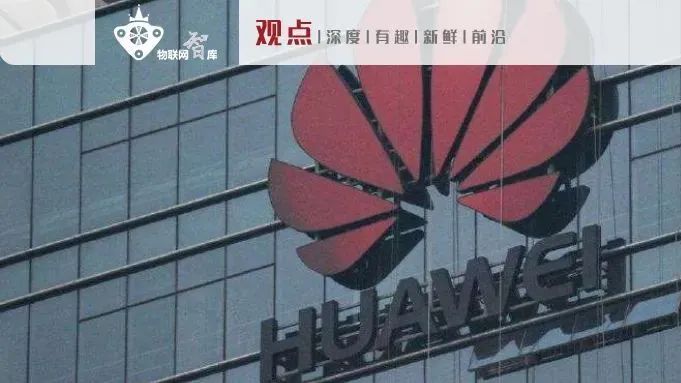Source: IoT Media (ulinkmedia)
IoT Think Tank Reprint
For secondary reprints, please contact the original author

Introduction
Whether it is NB-IoT or Cat.1, both face a situation of price (cost) competition at the chip and module level. However, for the application market, these two technologies will be the most common connection technologies in the future IoT, and the market value they can leverage will be limitless.
It is once again the back-to-school season, with schools across the country starting classes. Recently, a news story about a “strange” incident encountered by a primary school student at school has drawn attention:
A first-grade student named Xiao Xiao (pseudonym) living in Furong District, Changsha, found that when trying to contact her parents using a certain model of Xiaotiancai watch she was wearing, she was unable to make calls and the watch kept showing no signal.
It is reported that this watch was manufactured in April 2018, which is just over two years ago. The watch was functioning normally during the summer vacation this year, but suddenly showed no signal recently.
So why can’t this Xiaotiancai watch be used anymore?
After some investigation, it was finally discovered that this Xiaotiancai watch is a GSM terminal that uses 2G network to make calls, and the SIM card inserted in the watch is a secondary card used by her mother with China Unicom. Xiaotiancai’s customer service stated that the 2G network has now been shut down in that area by China Unicom, so the watch can no longer make calls.
China Unicom’s clean network plan has a long history,
and the 2G network shutdown is underway.
In fact, as early as 2018, China Unicom began to advance the shutdown of the 2G network, with an expectation to close all 2G networks before 2020.
Since 2018, various regional branches of China Unicom have gradually released relevant announcements, and now more and more users in various regions are experiencing a lack of 2G network signals, which means that the 2G network has moved from the planning phase of shutdown to the actual phase of shutdown.
According to information compiled online, the regions where China Unicom has closed the 2G network currently include:
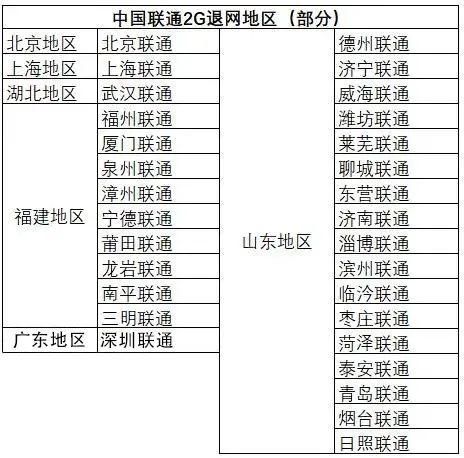
Compiled from the internet
In fact, regarding the 2G shutdown, the three major operators in China have officially started the shutdown process and have their own planned timelines. Although it will still take some time for the three major operators to completely and formally close the network, it is worth noting that before the actual shutdown date, the use of the 2G network has already begun to be restricted.
-
First, operators will stop activating new 2G devices before the network is shut down. If devices have already been connected to the 2G network, they can still be used, but new devices can no longer be registered.
-
Secondly, operators will reallocate the spectrum before the network is shut down, which means that pure 2G devices may not operate on the former 2G frequencies as they did before.
All three major operators have already cut off new users for 2G, so the current focus is on the existing 2G users, whose devices can mainly be divided into three categories:
1. The old 2G phones we recognize in remote areas;
2. Smart wearable devices like Xiaotiancai watches;
3. IoT terminal devices for enterprise use, such as PoS machines, smart locks on shared bicycles, remote meter reading systems for power and water utilities, smart locks, IoT gateways, smart appliances, smart monitoring devices, etc.
Therefore, once the 2G network is shut down, it will affect not only individual users but also some enterprise applications to varying degrees.
The impact of the 2G shutdown is significant,
why are operators so proactive?
The 2G shutdown is inevitable, so what are the benefits after the shutdown of 2G and even 3G networks?
First, it frees operators from the dilemma of operating at a loss.
Compared to 4G and 5G users, current 2G users have almost no value. In recent years, the profitability of operators has been declining, and the 2G network not only requires maintenance but also brings no revenue from users. Therefore, operators naturally hope to change this situation as soon as possible.
Second, it releases valuable frequency bands.
The 2G network occupies low-frequency bands such as 800M and 900M, which have strong penetration characteristics and can achieve good network coverage without the need to build a large number of base stations. Therefore, releasing and redeveloping these frequency bands for 4G and 5G networks can effectively enhance coverage capabilities and help operators capture more 5G users and revenue.
After the 2G network shutdown,
who will seize the opportunity?
As mentioned earlier, the scale of existing 2G users is still large. Regarding the reasons for the 2G network shutdown, how it will be shut down, and the specific timelines in various regions, the core concern for these users ultimately comes down to what they should do after the 2G network is shut down.
According to data, there were 671 million cellular IoT users in 2018, and the number reached 1.03 billion in 2019. By the end of July 2020, the number of cellular IoT terminal users reached 1.071 billion, and at the current growth rate, it is expected to reach 1.2 billion or even 1.3 billion by the end of the year.
Currently, among the existing cellular IoT users, 2G users still dominate, and this market needs other technologies to fill the gap.
According to the recent notice issued by the Ministry of Industry and Information Technology regarding the promotion of mobile IoT development, it is required that by the end of 2020, the number of mobile IoT connections should reach 1.2 billion.
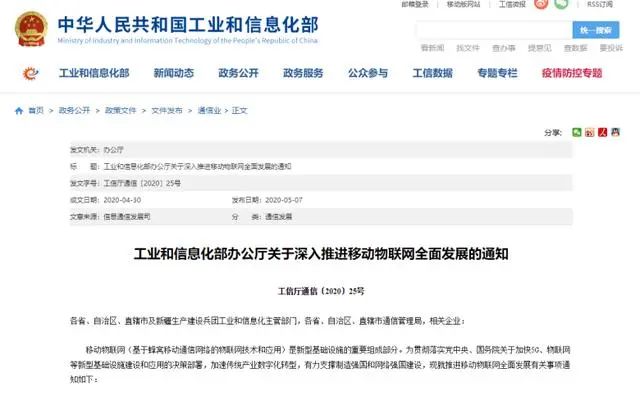
This notice clearly states that new IoT terminals should no longer use 2G/3G networks, and encourages the migration of existing 2G/3G IoT services to NB-IoT/4G (Cat1)/5G networks. The collaboration of NB-IoT and Cat1 will take over 2G/3G IoT connections, enhance spectrum utilization efficiency, and establish a comprehensive ecosystem for mobile IoT development involving NB-IoT, 4G (including LTE-Cat1), and 5G.
From the official document, it can be seen that 2G will officially exit the historical stage, and the main technologies to take over 2G/3G services will be NB-IoT and Cat.1. Below we will analyze the opportunities of these two new communication technologies.
NB-IoT
NB-IoT has been commercially available for almost three years. According to data previously released by operators, the cumulative number of NB-IoT SIM cards activated in the first half of this year has exceeded 100 million.
Of course, there will be some overlap in the activation numbers reported by the three major operators. According to my estimates, the overall market shipment volume of NB-IoT modules is around 60 million. Even so, the development momentum of NB-IoT remains strong.
NB-IoT’s technical characteristics are primarily reflected in low power consumption, low cost, small data volume, and fixed (non-mobile) scenarios. In such scenarios, NB-IoT will serve as a good replacement for 2G.
What about the industrial opportunities of NB-IoT? Let’s analyze it from the perspectives of chips, modules, terminal hardware, and solution providers.
First is the chip sector. Currently, there are already many chip suppliers in the domestic NB-IoT market, and they each have their own characteristics.
Qualcomm’s NB-IoT chip is a multi-mode product, and with its performance advantages and brand premium, it is considered a high-end product, more often chosen for foreign products.
HiSilicon’s NB-IoT chip is currently the mainstream in the domestic NB chip market, having been commercialized the earliest and verified for stability in the market. In contrast, Unisoc/MTK’s NB-IoT chip was launched later and has its own characteristics, with overall prices being somewhat lower than HiSilicon’s.
ChipWing and Yixin, two domestic startups, focus on high cost-performance NB-IoT chips. They have received recognition from many customers in the market, and mainstream module manufacturers are launching NB-IoT modules based on their chip products.
Of course, there are many more chip manufacturers eyeing the NB-IoT chip market, indicating a very lively market. However, NB-IoT chips belong to the general market, and to make profits, they need to achieve high volumes. Currently, market information suggests that chip prices are around $1, and as volumes increase, there will be room for optimization.
Thus, the market opportunities in this sector mainly depend on two aspects.
One aspect is to see how many NB-IoT units are shipped in a year. Given the current market’s annual application volume of several tens of millions, it is still insufficient; it needs to reach levels in the hundreds of millions. The fundamental factor for shipments is market demand. Currently, most NB-IoT applications are concentrated in water meters and gas meters, and the market growth requires more similar scenarios to support it.
The other aspect is market reshuffling. If market growth does not meet expectations, the NB-IoT chip market will inevitably undergo reshuffling, with some players exiting, leading to higher industry concentration.
Next is the module sector. There are many NB-IoT module manufacturers. It is understood that there are dozens of companies developing NB-IoT modules in the market. However, despite the large number of NB-IoT module manufacturers, the shipment volume concentration is also relatively high, with the top 5 manufacturers occupying most of the market.
The overall gross margin performance in the module sector is average, with industry reports indicating a gross margin of about 20%. Under the influence of both market and policy, the price of NB-IoT is driven lower, leading to lower margins. Therefore, to make profits, large volumes are needed, and module manufacturers with insufficient shipment volumes will gradually find this to be a “chicken rib” market.
Of course, module manufacturers also have another route to pursue, which is to develop customized hardware and solutions based on module products, depending on the market strategy of each module manufacturer.
Finally, there are terminal hardware and solution providers. Compared to chips and modules, this sector is more fragmented and customized, but it holds the highest overall industrial value.
This is understandable. The market price of an NB-IoT module is around $20 (with cheaper ones being over $10), while a typical hardware terminal, such as a water meter, costs about $200 to $300. Just from the product unit price, it is clear that this sector holds more value.
The market value that an NB-IoT chip (module) can leverage is not limited to this. On one hand, based on NB-IoT, more software data services can be developed, allowing hardware manufacturers to easily evolve into solution providers and expand their commercial margins; on the other hand, this also represents an opportunity for hardware manufacturers to upgrade their brands.
Cat.1
Compared to NB-IoT, Cat.1 offers faster transmission rates and includes mobility and voice calling features, thus effectively replacing certain other 2G scenario requirements. For instance, this includes locators, PoS machines, shared bicycles/electric vehicles, children’s watches, etc.
The difficulty of market development for Cat.1’s applicable scenarios is relatively low, and it does not face competition from other technologies such as LoRa and ZETA. Therefore, as soon as Cat.1 was launched, it became a new favorite in the industry.
In terms of various sectors, the overall industrial patterns are similar to those of NB-IoT.
Currently, in the chip sector, the players for Cat.1 chips are ASR and Unisoc. According to the information I have, there are also other manufacturers actively preparing for this market.
In the terminal application and solution sector, based on the information I have gathered, the market has already seen several million units shipped. The specific market performance is yet to be validated.
Copyright Notice: “IoT Think Tank” is committed to publishing excellent technology/research/investment articles in addition to original content. Some articles may be pushed without being able to contact the original author. If there are copyright issues or if the source of secondary reprints is incorrectly marked, please contact the original author. Contact: WeChat My_lordmiss
Previous Selections

Harbin Institute of Technology is too difficult! Exposed in the National College Student
Mathematical Modeling Competition to be banned……

Ultimate move! The US initiates
“Unlimited Traceability” against Huawei, blacklisting another 38 companies……
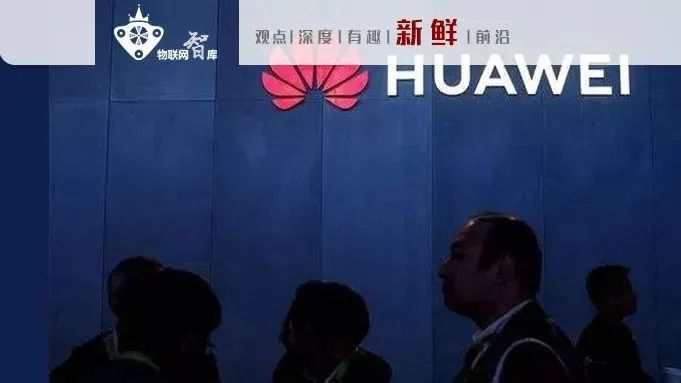
Huawei’s high-end Kirin chips may become obsolete,
Yu Chengdong: A countermeasure has been developed!
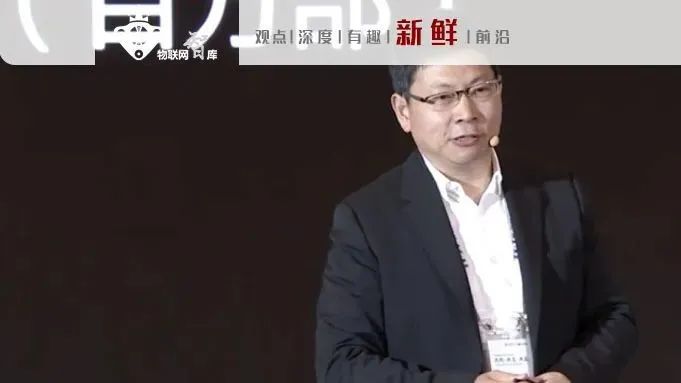
Just now, the US announced the “Clean Network” action:
Ban Chinese operators, prohibit the use of BAT Cloud……

History will remember today, we were robbed by the US
successfully! ByteDance agrees……
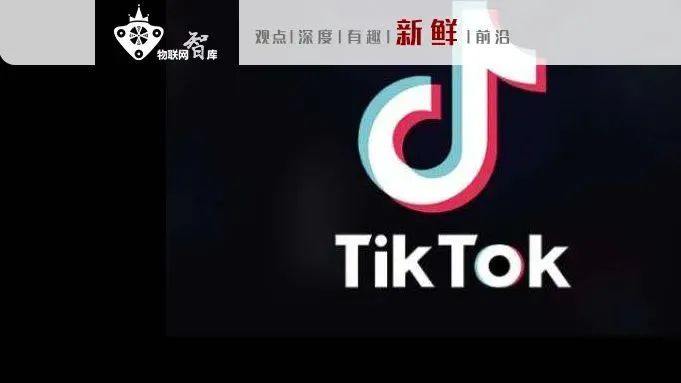
Huawei is set to enter the lithography machine manufacturing industry,
mass-producing 5nm lithography machines in two years?……
